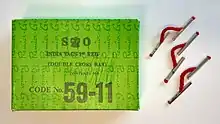Treasury tag
A treasury tag[1] or India tag[2] is an item of stationery used to fasten sheets of paper together or to a folder. It consists of a short length of string, with metal or plastic cross-pieces at each end that are orthogonal to the string. They are threaded through holes in paper or card made with a hole punch or lawyers bodkin or electric drill, and the cross-pieces are sufficiently wide as to not slip back through the holes.[3]

The names Treasury tag and India tag are first found on record in a list of stationery items published by Her Majesty's Stationery Office (HMSO) in 1912, and, both being capitalised, probably refer to HM Treasury and the India Office.[4][5] While the terms are now equivalent, a Treasury tag was originally a lace with a sharp metal tag at one end, which could be threaded through the holes in a stack of documents or cards and inserted into a corresponding tag at the other end, thus forming a loop and binding the documents. The tags, in that case, were in line with the string, similar to aglets on a shoelace.
References
- "treasury tag - definitions". Collins Dictionary. HarperCollins. Retrieved 28 June 2016.
- "India tag - definition of India tag in English from the Oxford dictionary". OxfordDictionaries.com. Oxford University Press. 2016. Retrieved 28 June 2016.
- https://www.youtube.com/watch?v=s1EmZOt8Pno
- List of Articles Authorised to be Supplied by H.M.S.O. Her Majesty's Stationery Office. 1912.
- "Treasury Tags at Paperstone". Paperstone Ltd. 2016. Retrieved 28 June 2016.